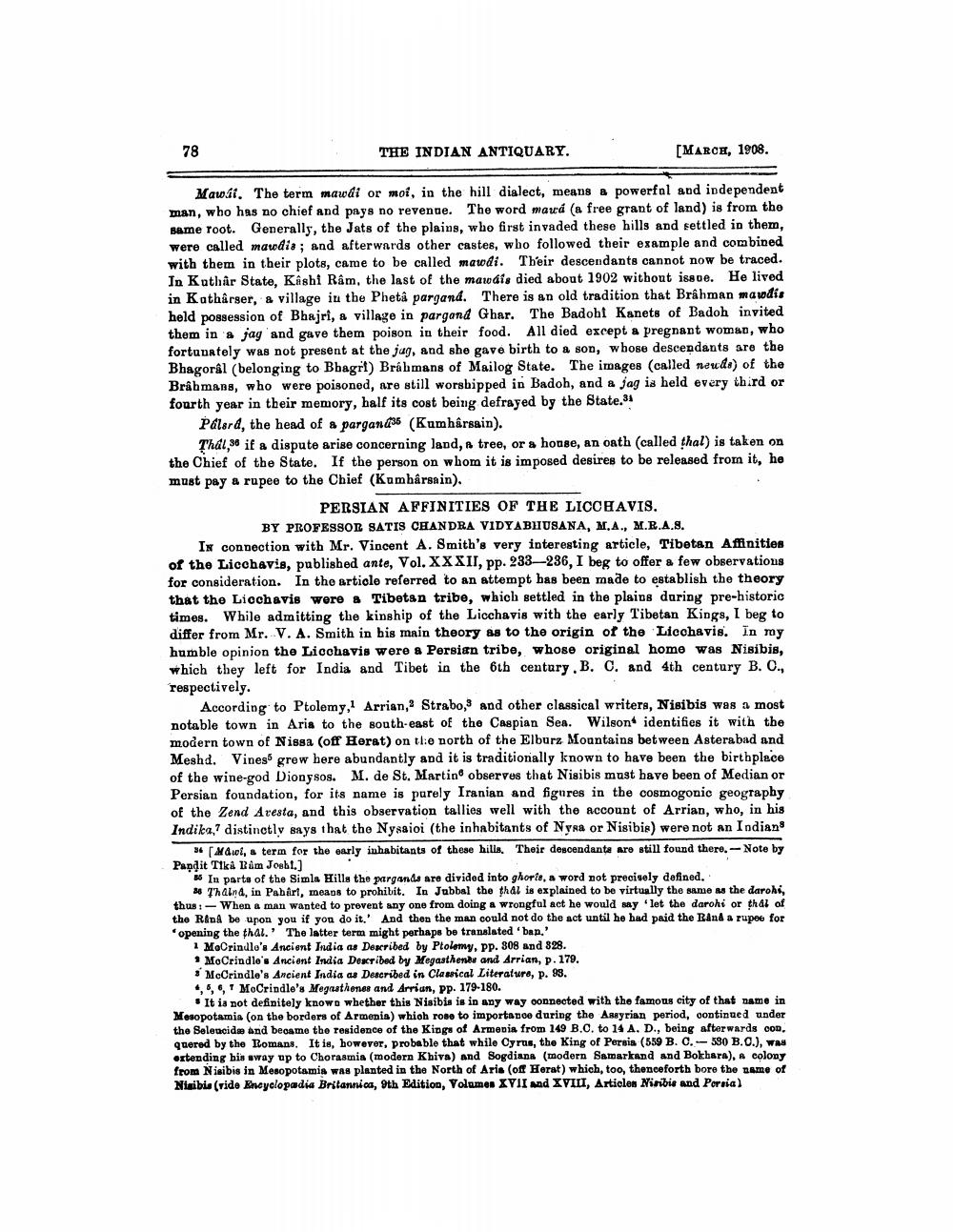________________
78
THE INDIAN ANTIQUARY.
[MARCH, 1908.
Mawii. The term mawdi or moi, in the hill dialect, means a powerful and independent man, who has no chief and pays no revenge. The word mavá (a free grant of land) is from the same root. Generally, the Jats of the plains, who first invaded these hills and settled in them, were called maudis; and afterwards other castes, who followed their example and combined with them in their plots, came to be called mardi. Their descendants cannot now be traced. In Kathar State, Kishi Râm, the last of the mardis died about 1902 without issue. He lived in Katharger, & village in the Pheta pargand. There is an old tradition that Brahman mandis held possession of Bhajri, & village in pargand Ghar. The Badobt Kanets of Badoh invited them in a jay and gave them poison in their food. All died except a pregnant woman, who fortunately was not present at the jag, and she gave birth to a son, whose descendants are the Bhagoral (belonging to Bbagrt) Brahmans of Mailog State. The images (called naudo) of the Brâhmans, who were poisoned, are still worshipped in Badoh, and a jag is held every third or fourth year in their memory, half its cost being defrayed by the State.
Palard, the head of a pargan (36 (Kumhârsain).
Thal,30 if a dispute arise concerning land, a tree, or a house, an oath (called thal) is taken on the Chief of the State. If the person on whom it is imposed desires to be released from it, he must pay a rupee to the Chief (Kumharsnin).
PERSIAN AFFINITIES OF THE LICCHAVIS, BY PROFESSOR SATIS CHANDRA VIDYABUSANA, M.A., M.R.A.S. In connection with Mr. Vincent A. Smith's very interesting article, Tibetan Affinities of the Licchavis, published ante, Vol. XXXII, pp. 233-236, I beg to offer a few observations for consideration. In the article referred to an attempt has been made to establish the theory that the Liochavis were & Tibetan tribe, which settled in the plaids during pre-historic times. While admitting the kinghip of the Licchavis with the early Tibetan Kings, I beg to differ from Mr. V. A. Smith in his main theory as to the origin of the Licchavis. in my humble opinion the Licchavis were & Persian tribe, whose original home was Nisibis, which they left for India and Tibet in the 6th century. B. C. and 4th century B. C., respectively.
According to Ptolemy, Arrian, Strabo, and other classical writers, Nisibis was a most notable town in Aria to the south-east of the Caspian Sea. Wilson identifies it with the modern town of Nissa (off Herat) on the north of the Elburz Mountains between Asterabad and Meshd. Vines grew here abundantly and it is traditionally known to have been the birthplace of the wine-god Dionysos. M. de St. Martin observes that Nisibis must have been of Median or Persian foundation, for its name is purely Iranian and figures in the cosmogonic geography of the Zend Aresta, and this observation tallies well with the account of Arrian, who, in his Indika,7 distinctly says that the Nysaioi (the inhabitants of Nyra or Nisibis) were not an Indians
Mawl, a term for the early inhabitants of these hills. Their descendants are still found there. -Note by Papdit Tiki Ram Joshi.)
5 In parts of the Simla Hills the pargands are divided into ghorie, a word not precisely defined.
28 Thain4, in Pabart, means to prohibit. In Jubbal the that is explained to be virtually the same as the darohs, thus - When a man wanted to prevent any one from doing a wrongful act he would my let the darohi or that of the RDA be upon you if you do it.' And then the man could not do the act until he had paid the Rand a rupee for *opening the thai.' The latter term might perhaps be translated ban.
1 MoCrinulo's Ancient India as Described by Ptolemy, Pp. 308 and 828. • MoCrindle's Ancient India Described by Megasthenku and Arrian, p. 170. Morindlo's Ancient India as Described in Classical Literature, p. 83.
%SMoCrindle's Megoathones and Arrian, Pp. 179-180.
. It is not definitely knows whether this Nisibis is in any way connected with the famous city of that name in Mesopotamia (on the borders of Armenis) which roso to importance during the Assyrian period, continued under the Seleucida and became the residence of the Kings of Armenia from 149 B.C. to 14 A. D., being afterwards con quered by the Romans. It is, however, probable that while Cyrus, the King of Persia (559 B. C.-530 B.O.), was ortending his way up to Chorasmia (modern Khiva) and Sogdiana (modern Samarkand and Bokhara). A colony from Nisibis in Mesopotamis was planted in the North of Aris (off Horat) which, too, thenceforth bore the name of Niibis (vide Encyclopadia Britannica, Oth Edition, Volumes XVII and XVIII, Articles Nimbia and Pornia)




